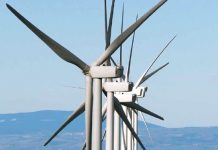After the production portal was commissioned last spring, Fraunhofer IWES reached the next milestone in the BladeMaker joint research project: Steps are now integrated as the basis for a prototypical end-to-end process.
The first step is producing the first shear web with direct infusion, followed by shear web manufacturing with PUR foam-core elements, the production of the first half of the form tool, and the testing of a new gripper principle for handling cuttings.
When the project is completed at the end of this year, all of the optimized processes will be merged and adapted to the production sequence. The 16 project partners have a goal of saving at least 10 percent in rotor-blade production along with noticeable quality improvements.
Production workflow automation should increase to about 60 percent. To achieve that, the industrial approach draws on new materials as well as optimized processes and illustrates the advantages of this production method, for example, taking a blade design developed by IWES. The blade design was based on a simplified turbine model with a capacity of 1.5 MW developed by IWES scientists.
A prime example from the field of process technology is the production of the blade mold without a master plug, which can save time by several weeks. The production of the mold for a rotor blade generally requires the creation of a master plug. Following this stage, the next step requires the form to be shaped manually in accordance with the blade geometry.
In combination with a project partner’s corresponding CAD-CAM tools, the use of a computerized numerical control makes it possible to pass the design data on to the production planning team directly. The same should occur for all hardware-dependent processes. In the BladeMaker project, the mold for the 18-meter-long root segment of a 40-meter rotor blade has just been produced without a master plug. This direct tooling approach can save about two weeks of production time. The mold is completed with a carbon fiber-based electrical heating system.
Cutting Costs
The shear web is often manufactured as a sandwich construction, which results in high rigidity and low weight. This component is one of the central parts employed to increase the buckling strength of a blade. The aim in the BladeMaker project is to produce the core of the shear web from polyurethane (PUR). Instead of kits made from PVC, for example, large-scale elements are prefabricated and inserted. The advantage: cost savings. The shear webs produced in Bremerhaven, both conventional and adapted versions, were inserted with a special tool (shear web positioner) that ensures optimal positioning within the half shell.
Innovative Gripper Principle
Another approach developed for the handling of stacked cuttings with high surface weights and fixed preforms is a gripper that grasps multiple flat cuttings and places them on a support. This allows for the next step of the shaping. The shaped stack is positioned precisely in the form tool using the gripper system.
“Robot-assisted cutting positioning, either directly or as a preform, translates to noticeable time savings, increases the precision, and ensures a consistent level of quality,” said Christian Dörsch, the team lead.
Completion of the integration and demonstration of all of the sub-processes is expected by the end of 2017. The machines need to be set precisely. The changing of the process heads and the changeover to the next production step will be performed at the same machine space, so it demands exact coordination. There is still a ways to go before the proprietary BladeMaker blade segment can enter its “maiden voyage” along the entire process chain.
The demonstration center is already opening its doors to blade manufacturers, suppliers of materials for rotor-blade production, and the mechanical engineering industry for test runs. The aim is to identify possible additional cost savings in the production chain.
Source: Fraunhofer
For more information, go to www.windenergie.iwes.fraunhofer.de/

























